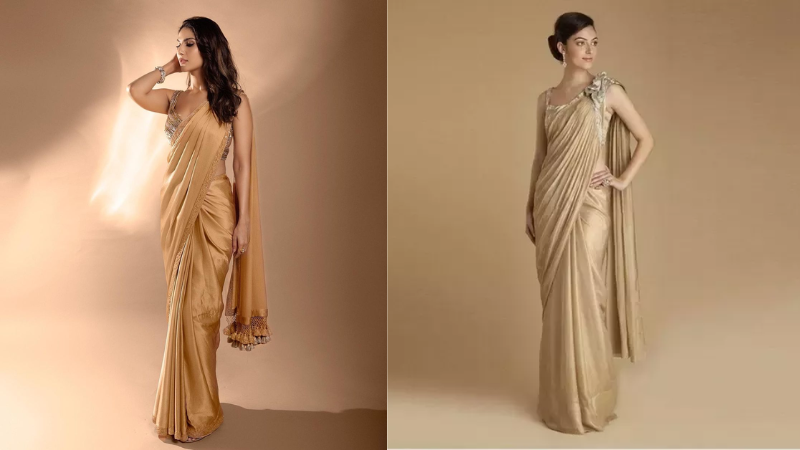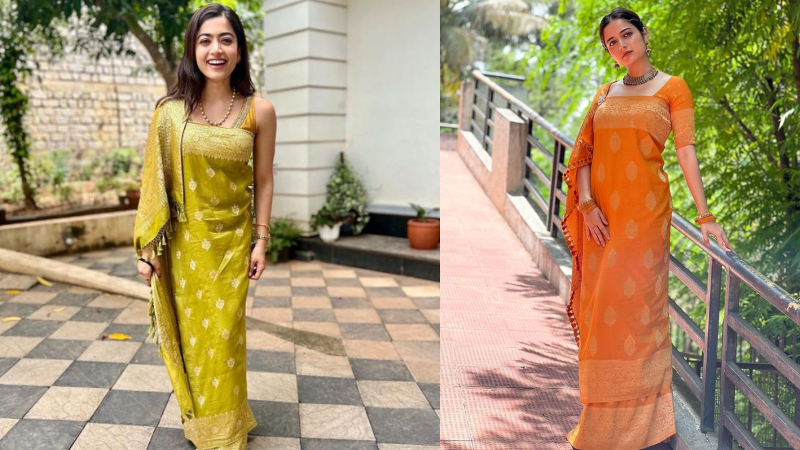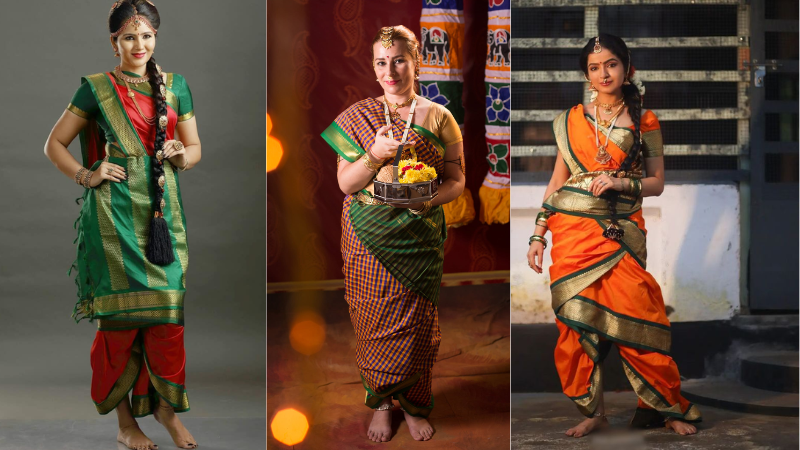The saree, a traditional Indian garment, is not just a piece of clothing; it is an embodiment of culture, heritage, and elegance. With its timeless appeal, the saree has transcended regional boundaries, finding its way into the hearts and wardrobes of women across India. In this blog, we will delve into the different saree draping styles in India across various Indian cultures, exploring the unique techniques and names associated with each style.
Join us on this captivating journey to gain a deeper insight into the rich world of sarees in India.
Nivi Style Saree Drapping (Andhra Pradesh and Telangana):

The Nivi style Saree, originating from Andhra Pradesh and Telangana. It is one of the most popular and widely recognized ways of draping a saree. It involves pleating the fabric and tucking it into the waist, with the pallu (the loose end) falling gracefully over the shoulder. The Nivi drape characterizes itself with simplicity and elegance, making it a versatile choice for various occasions. The modern draping style, originating from the Nivi saree drape, has now evolved into a global phenomenon, transcending its regional roots.
Atpoure Bengali Saree Drape (West Bengal):
The Bengali style saree is distinct and easily recognizable. The Nivi draping style involves creating multiple pleats in the front and tucking them into the waist. After draping the pallu over the left shoulder, you bring it around the back and tuck it into the left side of the waist. This style is often accompanied by ornate pins, known as “kantha,” that hold the pleats in place, adding a touch of grace and sophistication.
The traditional Bengali-style saree features a white color with a prominent red border. Women who hold the position of the household head, throughout history and continuing today, customarily attach a bunch of keys to the pallu. They drape the pallu over the right shoulder.
Gujarati Style or Seedha Pallu Saree (Gujarat):

The Gujarati style saree draping is characterized by the use of vibrant colors, heavy embellishments, and intricate pleating. The pallu is draped over the right shoulder and brought around the body to be pleated at the back, forming a fan-like effect. The pleats are then tucked into the waist, allowing the intricate details of the saree to take center stage. It can be seen in the states Uttar Pradesh, and Odisha other then Gujrat.
Maharashtrian Style or Nauvari Saree (Maharashtra):
The Maharashtrian style is also known as the “Nauvari saree” or “Kasta saree”. It is unique and represents the cultural heritage of Maharashtra. Unlike other styles, people drape the Nauvari saree in a way that resembles a dhoti. They wrap the saree around the waist and then tuck it in between the legs, forming loose pants-like drapes. They take the pallu from the back, bring it over the shoulder, and then pleat it at the front. People choose this style for ease of movement and often adorn it with traditional jewelry.
Explore the captivating world of Maharashtrian sarees! Click here to uncover their beauty and learn more.
Coorgi Style Saree (Karnataka):

The Coorgi saree drape is a distinctive tradition originating from the Coorg region of Karnataka. It showcases the artistry and elegance deeply rooted in the local culture. Unlike the conventional Nivi drape, it involves pleating the saree at the back and securing it on the left shoulder, creating a unique and enchanting effect. This draping style carries deep symbolism, reflecting the cultural identity of the Coorg community. Adorned with traditional jewelry and accessories, it adds a touch of regality to the overall ensemble.
Mekhela Chador Saree Drape (Assam):
The Mekhela Chador saree drape is a traditional style hailing from the beautiful state of Assam. This unique drape showcases the rich heritage and exquisite craftsmanship of the region. The Mekhela Chador is a two-piece ensemble consisting of a skirt-like lower garment called the Mekhela and a draped upper garment known as the Chador.
This drape stands out with its distinct elegance and cultural significance. The Mekhela, pleated and worn around the waist, gives a graceful and structured look. On the other hand, you drape the Chador over the shoulder, creating a cascading effect that enhances the overall beauty of the saree.
Madisaru Saree Drape (Tamil Nadu):

The Madisaru saree drape is a traditional style originating from the southern state of Tamil Nadu. This unique drape showcases the cultural heritage and artistic traditions of the region.
The Madisaru drape stands out with its distinctive draping technique and elegant appearance. Unlike the usual saree draping styles, the Madisaru style involves pleating the saree in a specific way and draping it over the shoulder, creating a graceful and structured look. The pallu, or loose end of the saree, is often pleated and secured at the waist, giving it a neat and sophisticated appearance.
Mundum Neriyathum Saree Drape (Kerala):
The Mundum Neriyathum saree drape is a traditional style that originated in the southern state of Kerala. This unique drape showcases the cultural heritage and simplicity of the region. The Mundum Neriyathum drape characterizes a two-piece ensemble consisting of the Mundu (lower garment) and the Neriyathu (upper garment). People wear the Mundu as a plain white or off-white piece of cloth, like a skirt. They drape the Neriyathu over the shoulder, and it falls gracefully to the front and back.
What sets the Mundum Neriyathum saree drape apart is its elegance and cultural significance
Conclusion: The saree is a testament to the cultural diversity and richness of India. Each region boasts its own unique style of draping, reflecting the traditions and customs of that particular culture. From the simplicity of the Nivi style to the grandeur of the Maharashtrian Nauvari saree, each style has its own charm and significance. Exploring the diverse ways of wearing the saree provides a deeper understanding of its beauty and versatility. It is an opportunity to appreciate this iconic Indian garment.
Our nation offers a range of varieties that extends far beyond what we have mentioned. It would be imprudent to claim that we can capture all these countless varieties in a single document. We cannot fully describe the immense diversity of our nation in a limited space. However, it testifies to the vastness of our land, which embraces diversity while fostering harmony under one shared sky.
So, let us celebrate the artistry and elegance of saree draping and embrace the myriad styles that adorn the women of India with grace and panache.


